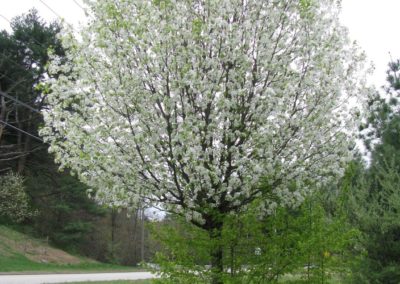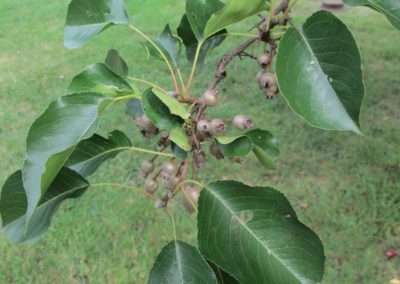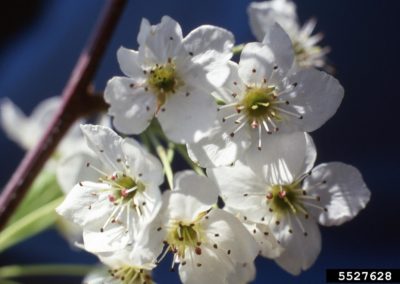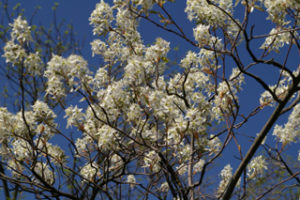Callery (Bradford) Pear (Pyrus calleryana)
Invasive Management Profile
If you are outside in the spring and summer smelling the odor of rotten fish, you may be smelling a Bradford Pear. The Bradford Pear has become a popular ornamental tree in Indiana due to its beautiful, yet stinky blossoms. Besides their fishy odor, Bradford Pear trees are fast growing and disease resistant, which causes them to overpower native plants and take over landscapes. “Over time the different varieties of the ornamental pear trees have cross-pollinated and that’s allowed them to rapidly spread into our natural resources.” – Megan Abraham of Indiana Department of Natural Resources.
Identification
A Bradford Pear will grow up to 25 feet in height with light grey bark. Bradford Pear leaves are oval to heart-shaped 2 to 3 inches long and wide with small teeth around the edges, which means it resembles the shape of a saw blade. In the summer, the top of the leaf is a shiny green while the bottom side is a dull green in the fall, the leaves turn reddish purple. Beginning in May white flowers less than an inch long grow in clusters and give off the rotting fish smell. From May to July a small olive-brown round fruit no longer than 1/4 inch long will appear.
Tools & Supplies Needed
- Chainsaw
- Protective eyewear, gloves, and clothing
- Hatchet or small Axe
- Herbicide
- Plastic or Paper Bag
Removal Methods
STEP 1 : Identify plant using our identification tips and photos as well as the time of year and growth stage.
STEP 2 : Wear protective eyewear, gloves and clothing.
STEP 3 : Using an axe or chainsaw cut the tree 5-10 inches from the ground. Be aware of your surroundings and always wear protection when using this equipment.
STEP 4 : Treat with herbicide or remove root system. For removal of the root system, start digging 3 feet away from the base of the stump.
STEP 6 : Once you can see the majority of the rootball, slide your shovel under it and gently begin loosening and prying it up, away from the ground.
STEP 7 : Once the rootball is free place it and all clippings on a tarp to stop the spreading of seeds or regrowth.
One of the simplest methods to kill a full grown Bradford Pear Tree is to girdle it.
STEP 1 : Identify plant using our identification tips and photos as well as the time of year and growth stage.
STEP 2 : Wear protective eyewear, gloves and clothing.
STEP 3 : Use a small hatchet and remove an entire ring of bark around the tree. Make the cut at least 1½ an inch deep. This will stop the flow nutrients to the rest of the three and slowly kill it.
STEP 4 : Apply herbicide to the removed area to help speed up the process. Click here for herbicide use information.
STEP 1 : Identify plant using our identification tips and photos as well as the time of year and growth stage.
STEP 2 : Wear protective eyewear, gloves and clothing.
STEP 3 : Use your hand to grab the bottom of the plant, twist and pull.
STEP 4 : When pulling, make sure to remove the taproot, which is the main root system (This may be easily removed with a spade or shovel as well).
STEP 5 : Make sure to place all plant debris into a plastic or paper bag to control seed spread.
Disposal
For disposal of Bradford Pear, package the plant waste in a large plastic or paper bag for landfill. Small plants can be disposed of in the trash and will be picked up through regular trash collection. Large Bradford Pear trees can be picked up through the city’s heavy trash collection provided they are tied into bundles no larger than 3 feet by 3 feet. Heavy trash collection guidelines and monthly pick-up days for your address can be found here.
Beyond trash collection services, you may need to either hire someone to come and remove the yard waste generated from your Bradford Pear removal or haul the waste away yourself. Many landscaping companies will accept yard waste for a small cost. They then process this material into mulch or compost. Click here to learn more about tree removal services in your area.
Native Alternative Species
To learn more about natives and how to landscape with them click here.
Serviceberry (Amelanchier laevis)
|
Growth Type: Tree
Height: 15 to 40 feet
Spread: 15 to 40 feet
Bloom Time & Description: April; showy white fragrant flower
Fruit: Showy, Edible
Light exposure: Full sun to part shade
Attracts: Birds
Tolerate: Air Pollution
|
Photo Courtesy of INPAWS |
Flowering dogwood (Cornus florida)
|
Growth Type: Deciduous Tree
Height: 15 to 30 feet
Spread: 15 to 30 feet
Bloom Time & Description: April to May; showy white flower
Fruit: Showy
Light exposure: Full sun to part shade
Attracts: Birds, Butterflies
Tolerate: Deer, Clay Soil, Black Walnut
|
Photo Courtesy of Lady Bird Johnson Wildflower Center |
Roughleaf Dogwood (Cornus drummondii)
|
Growth Type: Deciduous shrub
Height: 6 to 15 feet
Spread: 6 to 15 feet
Bloom Time & Description: May to June; showy yellowish- white flower
Fruit: Showy
Light exposure: Full sun to part shade
Attracts: Birds, Butterflies
Tolerate: Deer
|
Photo Courtesy if INPAWS |






